Where Is It Worth Using Hydrogen? Application Areas in the Energy Revolution
Hydrogen in BremenApplication areas for climate-neutral hydrogen
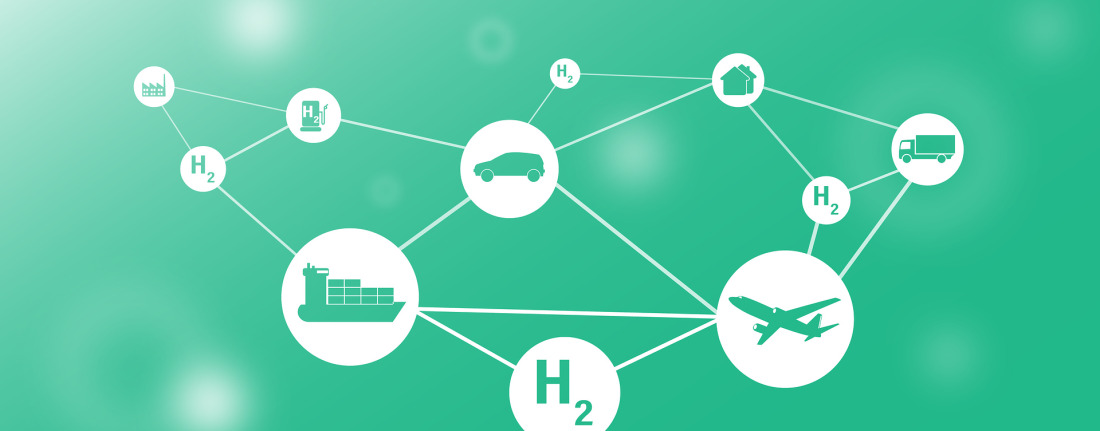
Is climate-neutral hydrogen worth it? This isn't a question that can be answered with a blanket "yes" or "no". There are simply so many different application areas: for vehicles, aircraft, ships or industrial use. You have to investigate much more deeply if you want to find an answer to the question of how and where hydrogen can be used.
This highly flammable gas is now considered to be an important element in the energy revolution. However, the implication here is that it is always climate-neutral or "green" hydrogen that will be used. If the electrolysis process is used to obtain hydrogen gas from water, and the electricity for this process is generated using renewable energies such as wind or solar power, then the hydrogen is green because no emissions are released during its generation and use.
The situation for grey hydrogen, on the other hand, looks quite different. At present, this type of hydrogen is most commonly used in Germany (more than 95 percent). This is primarily obtained from natural gas. This production method (known as "steam reforming") releases CO2 and is therefore damaging to the environment. (There are also many other colours of hydrogen, which are not discussed any further here.)
Contents
- Potential Areas In Which Hydrogen Can Be Used In Industry And Transportation
- Green Hydrogen And Electricity Production In Germany
- 1. Is It Worth Using Hydrogen For aircraft?
- 2. Is It Worth Using Hydrogen For Ships?
- 3. Is It Worth Using Hydrogen For Trains?
- 4. Is It Worth Using Hydrogen For Cars?
- 5. Is It Worth Using Hydrogen For Utility Vehicles And Public Service Vehicles?
- 6. Is It Worth Using Hydrogen For Industrial Applications?
- 7. Is It Worth Using Hydrogen To Generate Heat For Domestic Households?
- 8. Is It Worth Using Hydrogen As A Means Of Storing Electricity?
- Summary: Where Is It Worth Using Hydrogen?
Potential Areas In Which Hydrogen Can Be Used In Industry And Transportation
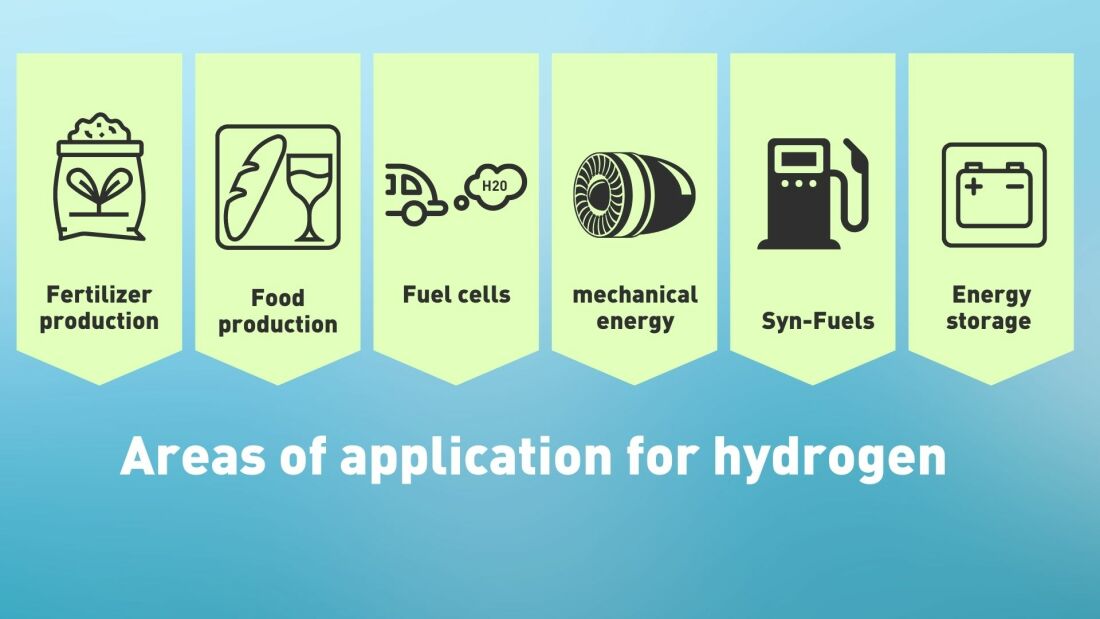
Nowadays, hydrogen be used in a host of different ways:
- hydrogen is primarily needed for chemical conversion processes. For example, for generating ammonia in the Haber-Bosch process. This is one of the world's most important industrial process for creating the elements for fertilizer. Hydrogen is also used in oil refining and as a bleach (hydrogen peroxide).
- In industrial processes, it acts as an inert gas. It is needed to manufacture metal and glass and also in the food industry (in fat hydrogenation)
- Fuel cells generate electricity from hydrogen and atmospheric oxygen in a chemical process. They are mainly used in vehicles.
- However, motors, turbines and burners can also burn hydrogen directly, in the same way as, for example, natural gas. The objective is to either generate heat or drive mechanical processes such as an aircraft turbine.
- Hydrogen can be converted into hydrocarbons such as methane, methanol, gasoline and kerosene, which are known as derivates or synfuels, and which can be used as fuels in this form. This conversion process needs carbon, for example in the form of CO2.
- Finally, hydrogen can be used as a means of storing energy, when the excess electricity generated by wind or solar installations is converted into hydrogen and then stored.
Green Hydrogen And Electricity Production In Germany
Hydrogen is versatile and can be used in many areas. However, ensuring this gas can play its role as a source of green energy in these applications relies on the use of renewable energies, because it takes huge amounts of green electricity to derive hydrogen from water.
This is why, in future, the amount of power generated from renewable sources must not simply be enough to replace the electricity generated from fossil fuels. Even more must be generated from renewable sources, to provide the capacity needed to generate hydrogen as well. The Federal Government's current plans state that Germany should generate 80 percent carbon-neutral power from 2030 onwards.
If, in future, Germany is unable to produce the hydrogen it requires on its own, (and that is very likely), it will have to rely on importing energy, just as it does today. In its national hydrogen strategy, the German Government forecasts a demand of between 90 and 110 terawatt hours (TWh) by 2030, with domestic energy production of 14 TWh.
In future, hydrogen will be used in a multitude of applications, replacing natural gas or oil in many areas, but not all. For example, gas-fired power stations can be replaced by wind power, solar plants and energy storage systems, but not by hydrogen. However, there is no alternative to hydrogen in some industrial processes. For example, hydrogen is needed as the base material for synthesising (producing) ammonia.
In which sectors does it make sense to use hydrogen today? We will investigate the various application areas here and attempt to find out how hydrogen can be used in them.
Where Is It Worth Using Hydrogen? Eight application areas
1. Is It Worth Using Hydrogen For aircraft?

The aviation industry is faced with enormous challenges if it aspires to be carbon-neutral. First and foremost, the technical solutions must be simple and safe. Kerosene is an energy-dense fuel and the sector has decades of experience in handling this propellant.
Batteries can only be used to a limited extent. An example shows why: kerosene has an energy density of 43 megajoules (MJ) per kilogramme, whereas lithium ion batteries can currently only provide 0.65 MJ/kg. Using today's battery technology, and converting the energy density of the kerosene carried on board into battery weight, a jumbo jet could never take off because it would weigh 12,000 tonnes. For this reason, batteries would only be of interest for light aircraft on short domestic flights, because they have a better power to weight ratio.
A realistic alternative to batteries are SAFs (Sustainable Aviation Fuels). These can be extracted from biofuels, for example. However, biofuels are increasingly attracting criticism because they reduce the amount of agricultural land that can be used for food production, create fields of monoculture crops and therefore have a negative environmental footprint. Although SAFs are currently also derived from residues and waste from the food industry, there is still a question mark over whether people can produce enough reusable waste to keep the aviation industry going.
This creates an opportunity for hydrogen. At present, there are two possible approaches:
Approach 1: hydrogen drives
In its liquid state, hydrogen has exceptional energy density (at -252.9 °C), which makes it attractive for aviation. The gas could be used either to drive conventional turbines directly or used in fuel cells, to supply electricity to propellers.
For this reason, aircraft manufacturers such as Airbus are working on developing hydrogen-powered aircraft for short- and medium-range routes (up to approximately 3,500 km). These aircraft are not yet suitable for long-haul routes because despite hydrogen's advantages, its use still faces a number of technical and design hurdles: At present, hydrogen tanks can only be installed in the aircraft fuselage and they are high-pressure containers, so they must be spherical, to ensure they can withstand that pressure. This, in turn, reduces the space in the aircraft itself. The tanks to provide the fuel for long-haul flights would simply have to be too big. In addition, they must be cooled to ensure the hydrogen remains liquid. Finally, although hydrogen itself is light, four times the volume is required to produce the same amount of energy as kerosene. This is why it achieves a comparatively lower range than a similar volume of conventional fuel.
ECOMAT research centre
Hydrogen presents significant challenges to the next generation of aircraft. One place that is currently already developing the aircraft of tomorrow is the ECOMAT research centre in Bremen, Germany. This is where expertise in the aviation and aerospace industries meets materials science to find new solutions. Fuel tank design is one of the specialist areas in which the scientists in Bremen are involved. Airbus is also working on new solutions with a host of Bremen institutes.
Approach 2: synfuels
Instead of burning hydrogen directly, you can also use the gas to obtain synthetic fuels such as methanol (example project in Northern Germany: Atmosfair, the Lufthansa Group). This process, known as the "power-to-liquid" process, synthesises hydrogen with CO2 from the air to obtain "artificial fossil fuels". Although burning this fuel does produce CO2, it is carbon-neutral, as no new carbon dioxide is released (because the carbon dioxide was originally removed from the atmosphere when the fuel was created).
The disadvantage of these processes: they are energy-intensive, because electricity is needed both for the electrolysis process and then the subsequent synthesis. The amount of energy lost before the fuel reaches the aircraft also makes syn-fuels comparatively more expensive than similar processes. Due to their high energy density, they are therefore more suitable for long-haul flight applications. In addition, conventional machines can be filled with these fuels, which means an existing airline fleet can fly carbon-neutrally with very few modifications. Given that aircraft have an operational life of around 40 years, this is a very important consideration.Which procedure comes out ahead in the end will greatly depend on future technical developments, innovations and the regulatory agenda, and also on the time frame in which climate-neutral aviation is to become a reality.
2. Is It Worth Using Hydrogen For Ships?

Interestingly, when it comes to alternative propulsion systems, shipping faces similar challenges to aviation. The greater size of hydrogen tanks means they require much more space than a conventional marine fuel tank, which reduces both loading capacity and range. To ensure international shipping is not put at risk, the safety requirements are also very high.
Despite this, hydrogen is an extremely promising candidate for shipping applications because ships can be modified to run on fuel cell drives fairly easily and, unlike aircraft, ships do not need to be completely redesigned. A study performed in 2020, investigating shipping traffic between China and the USA, came to the conclusion that the majority of all journeys would be possible, with only minor changes to ships' fuel capacity or operations (see PDF). It is only on the long routes taken by giant container ships that the space required for hydrogen would increase enormously.
As in aviation, alternative fuels (synfuels) are also an option for the shipping industry. However, this involves the same challenges regarding efficiency and costs as in aviation. The first commercial ships running on a dual fuel system are already in planning or in construction: the Danish shipping line Maersk is building a container ship that will run on methanol.
The first ships powered by hydrogen, such as the MF Hydra, an 82-metre ferry that operates in Norway, are also on the move. However, these projects are still in the prototype and testing stage.
3. Is It Worth Using Hydrogen For Trains?

61 percent of the German railway network is electrified. Extremely efficient electric locomotives, which account for 90 percent of the entire transport service, run along its electrified tracks. The remaining 10 percent of routes is covered by diesel locomotives. This is a potential area in which hydrogen can be used, in particular because it is also these less well-travelled routes that are unlikely to be fully electrified in future.
An example of this is the Buxtehude – Bremerhaven – Cuxhaven line, on which a local train powered by a fuel cell has been tested and which will come into regular operation in future. Trains driven by hydrogen fuel cells have a better range than purely battery-driven trains, and can achieve around 1,000 kilometres on a single tank. The positive experiences gained in the first few years have inspired the German Federal State of Lower Saxony to procure more hydrogen-powered trains.
Another project is the electrification of shunting locomotives by using fuel cells as is currently envisioned at the port in Bremerhaven. In just the same way as for trucks (see point 5), experiments in converting locomotives from using combustion engines to hydrogen-powered systems are currently running. This should be less expensive than total conversion to fuel cell drives.
4. Is It Worth Using Hydrogen For Cars?
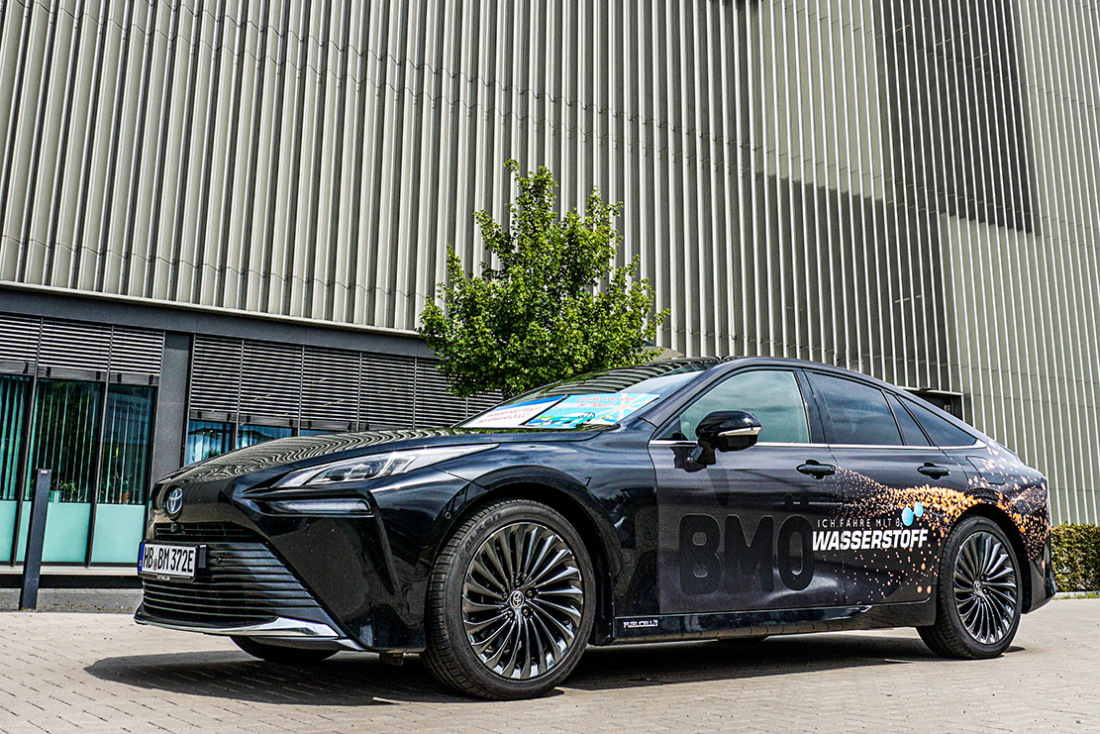
Using fuel cells in cars is not a new idea. In 1966, General Motors presented the first fuel cell-powered vehicle, the "Electrovan". In Europe, it was the German Aerospace Center (the DLR) that showcased a fuel cell-driven car in 1978. Both of these vehicles were prototypes that were not followed up, a fate shared by many hydrogen-powered cars over the following decades. It wasn't until 2014 that the car manufacturer Toyota went into series production of the "Mirai", opening a new chapter in this story.
However, hydrogen-powered cars have not yet become a mass phenomenon, whereas battery-driven cars are currently experiencing a boom. Why is that?
The energy efficiency of the hydrogen system
A major problem, and one that affects not only cars but also any application in which hydrogen gas is used as a means of storing energy, is the low overall efficiency of the system. First of all, electricity (generated from wind or solar power) is used to split water into its component atoms. Then the hydrogen must be stored and transported to its place of use before it actually gets into the car. The car itself then converts the hydrogen back into electricity to drive the engine and the wheels. These many conversion and transportation processes result in a lot of energy being lost: currently, it is assumed that between 60 and 70 percent is lost. In contrast, a purely battery-based system has a typical loss of between 10 and 20 percent.
This enormous loss of energy is not only inefficient, but also expensive, because the lost electricity will still have had to have been generated. Fuel cell systems are therefore at a disadvantage to batteries, which are increasingly becoming less expensive.
Costs and coverage
Due to inefficiency and the low industrial production capacity for green hydrogen, to date, the price per kilogram today is still comparatively high. 100 kilometres in an H2 car costs approximately 8 Euros, in contrast to approximately 4.50 Euros in a battery-driven electric car. However, both these vehicles are still cheaper to run (now that petrol costs over 2 Euros a litre in Germany) than a petrol-driven vehicle, when only the distance covered is compared (ignoring purchase cost, running costs, maintenance, wear etc.).
There is also the fact that Germany currently has around 94 hydrogen filling stations and 14,500 conventional fuel stations. Depending on where you live, even the journey to fill up your car may take a while, making the vehicle more expensive to run. At the same time, investing in the infrastructure for hydrogen is not an attractive prospect for filling station operators if there's hardly any demand for it: a classic chicken and egg problem.
Although it can be assumed that the planned expansion of electrolysis capacity in future years will reduce the cost of hydrogen, research is also continuing on newer, ever more efficient batteries.
Unlike a battery-driven car, a hydrogen-powered vehicle needs additional components such as the tank or fuel cell, which involve additional costs and require maintenance. However, like gasoline, you can fill your car's tank with hydrogen in a matter of minutes, whereas battery-driven cars need several hours to charge if there are not enough rapid charging stations available. This could be a relevant factor, especially in larger cities.
Hydrogen's future as a source of power for domestic vehicles greatly depends on technical developments and also on the expansion of the necessary infrastructure.
5. Hydrogen for utility vehicles and public service vehicles
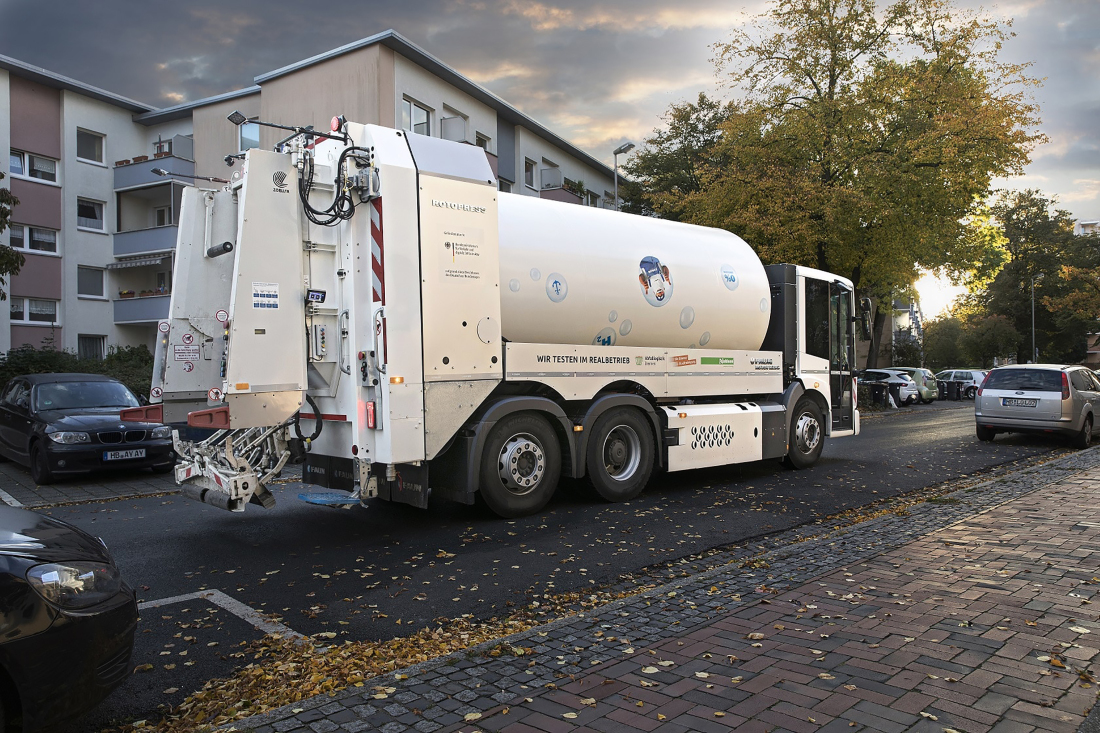
An interesting use case is utility vehicles. This is where it might be worth using hydrogen. Trucks simply have more space than cars in which larger tanks can be installed. This gives them a greater range.
Trucks are also driven for more hours: on average, a car is used for around 45 minutes a day, whereas trucks and buses are driven for between 6 and 8 hours and can be operated for longer. This greater period of use means more fuel is used and, in the case of batteries, longer charging times. In contrast, hydrogen-powered trucks could be refuelled in a matter of a few minutes, just like diesel-driven vehicles: a definite advantage.
Batteries are also extremely heavy and are much larger than a hydrogen fuel cell. Depending on a truck's required range, it might need very large battery packs. This increases the vehicle's unladen weight and reduces the amount of permitted weight and volume of freight it can carry.
Green utility vehicles from ENGINIUS
It is for these reasons that FAUN, a manufacturer of municipal vehicles, has chosen hydrogen. In the German Federal State of Bremen, the company is currently manufacturing dustbin lorries powered by fuel cells, with the brand name ENGINIUS. In future, it will also start series production of trucks with the same technology.
FAUN is also part of the "Hyways for Future" research project. With investments of 90 million Euros, this project aims to create an integrated hydrogen-based economy encompassing the creation, transport and storage of hydrogen, as well as its consumption, to investigate the interplay of the different stakeholders in the value creation chain.
In addition to fuel cell drives, companies such as MAN, the truck manufacturer, are working on using hydrogen in internal combustion engines . This would make series vehicle production on existing production lines easier. However, it is still not clear whether this would be more cost-effective than a fuel cell in the long run.
However, the use of hydrogen in utility vehicles is still far from a foregone conclusion. This is because work on purely battery-based solutions has already been going on for some time. In 2023, Tesla wants to start production of the "Semi", an articulated lorry (whose name comes from the American name for this kind of vehicle, "semi-trailer truck") with a range of up to 800 kilometres. The Fraunhofer Institute for Systems and Innovation Research (ISI) expects that battery-powered electric trucks for short and medium-distance routes will become cheaper and therefore more attractive, whereas hydrogen will be used for long-distance routes and special applications. Disadvantages such as long charging times should be offset by what are known as megawatt chargers, which can even charge trucks within a reasonable time. Another project involves erecting electricity lines, similar to those used by a trolleybus, above motorways. The first pilot projects have already been running for a number of years.
The two solutions are already in use beside each other in bus transport applications. For example, electric buses operate on five routes in Bremen, whereas the used of hydrogen-powered buses is being tested in Bremerhaven. Due to the relatively low number of kilometres buses travel each day (approximately 300 kilometres), batteries are less of a hindrance than in long distance routes. In Bremerhaven, the hydrogen bus is also part of a larger experiment which is investigating the creation, storage and use of hydrogen in a single system, for practical applications. Thanks to its proximity to sources of renewable energies, the seaport city is the ideal location.
6. Is It Worth Using Hydrogen For Industrial Applications?
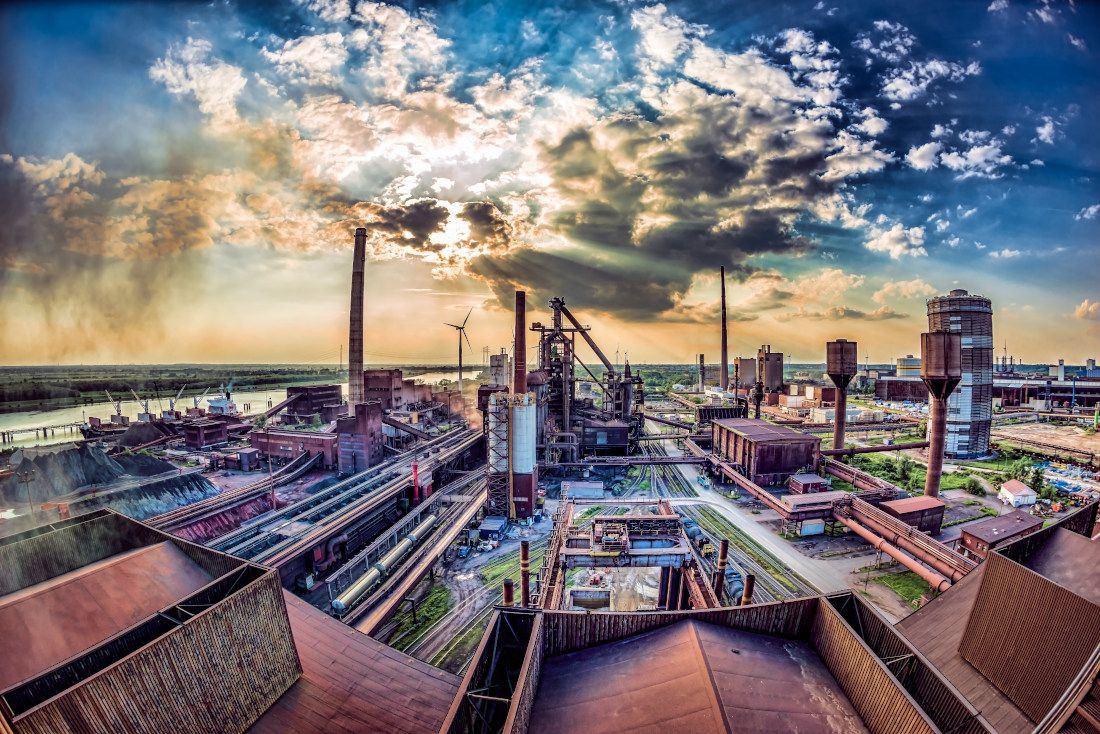
In 2019, 115 megatonnes (= million tonnes) of hydrogen was used by industry world-wide. Almost all of it came from fossil sources. Hydrogen is used in a multitude of ways in the processing and chemical industries and the gas is already needed in vast quantities today. Converting from grey to green hydrogen here alone could significantly reduce the global level of CO2 emissions.
A major proportion of what is currently grey hydrogen is used in the production of ammonia (31 megatonnes) in the production of fertilisers and methane (12 megatonnes) for adhesives, dyes, lubricants and propellants. In these cases, hydrogen cannot simply be replaced by a different material or another means of storing energy (such as batteries) and so it must therefore be produced using "green" methods. However, no new processes or design solutions will be needed to make the use of green hydrogen easier, once either market forces or regulatory specifications make it attractive.
Then again, there are opportunities for replacing the fossil fuels used in other industrial sectors with green hydrogen. For example, the steel industry, which accounts for seven percent of Germany's annual CO2 emissions, would be a potential application area.
Hydrogen project in the steel plant in Bremen
As Bremen's largest emitter of CO2, the ArcelorMittal steel works is facing a major challenge associated with the energy revolution. The "Hybit" project involves, among other things, the installation of a 12 MW electrolyser with the aim of achieving the changeover to green steel production. In future, the project will become integrated in the North German hydrogen economy.
The glass manufacturing industry also generates high levels of CO2 emissions because gas burners are used to fuse together the base materials. Currently, every tonne of glass produces almost one tonne of CO2. The first pilot projects using hydrogen are already under way.
Hydrogen is also needed in many other sectors of industry such as in the manufacture of spreadable margarine in the food industry or in the chemical recycling of waste materials. Industrial processes are a huge area of opportunity for the use of green hydrogen and in future will also become a priority sector for its use.
7. Is It Worth Using Hydrogen To Generate Heat For Domestic Households?
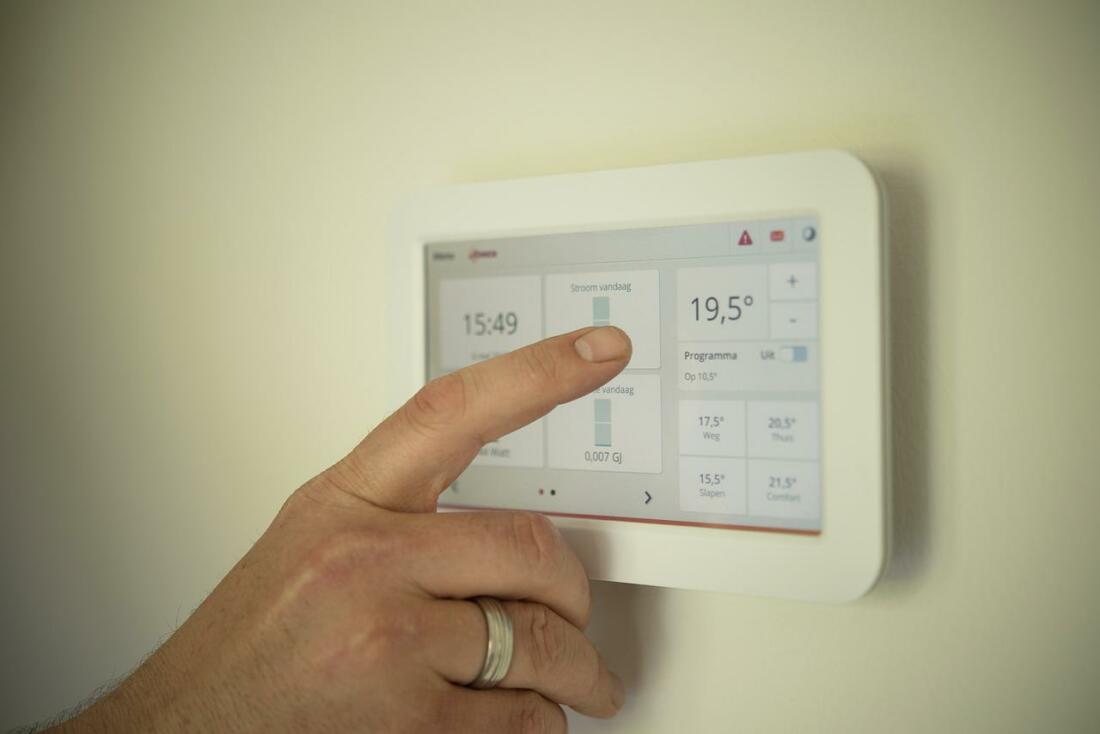
Around half of all German households are heated by natural gas. Gas heating systems can also run on hydrogen. Adding hydrogen to the natural gas can reduce CO2 emissions (see PDF, page 88). Although it is theoretically possible to convert completely from natural gas to hydrogen, there are technical issues involved, because conventional natural gas pipework is not designed to purely use hydrogen. Parts of the network must be modified to achieve this.
As in other sectors, hydrogen's low efficiency stands in the way of it being used in the construction industry. Air heat pumps are much more efficient when it comes to the energy produced per kilowatt hour because they are driven directly by electricity and there's no need for the electricity-hydrogen-electricity conversion process. Air heat pump technology is also well-established and is already in widespread use.
However, hydrogen can play a bridging role here until a transition to other heating technologies has taken place or be used as an environmentally friendly heating gas in places where this isn't possible for other reasons. Hydrogen could be used as a niche application in cases where power and heat have to be generated decentrally or, for example, where the aim is to create a stand-alone combined electricity generation, energy storage and consumption system.
8. Is It Worth Using Hydrogen As A Means Of Storing Electricity?
In the transportation sector, hydrogen is primarily used as a means of storing energy, to provide wind and solar power on the street, in the air or at sea. For this reason it is also competing with battery technology in these areas.
However, hydrogen can also take on an important role in stationary electricity generation. This is because the wind and the sun are volatile energy sources. These systems don't generate energy on calm days or at night, whereas they quickly produce more than is needed during storms or in high summer. On a few days a year, renewable energy systems already supply more electricity than Germany actually then needs.
This imbalance between supply and demand can be mitigated by energy storage systems. These systems provide electricity when the wind and solar power systems supply too little and collect electricity when more is generated than the network can handle. At present, a plethora of energy storage solutions with greatly differing storage capacities are under discussion, whether for storing electricity directly in huge battery systems, or for storing energy indirectly in water storage power plants, liquid salt, compressed air or even mechanical storage systems.
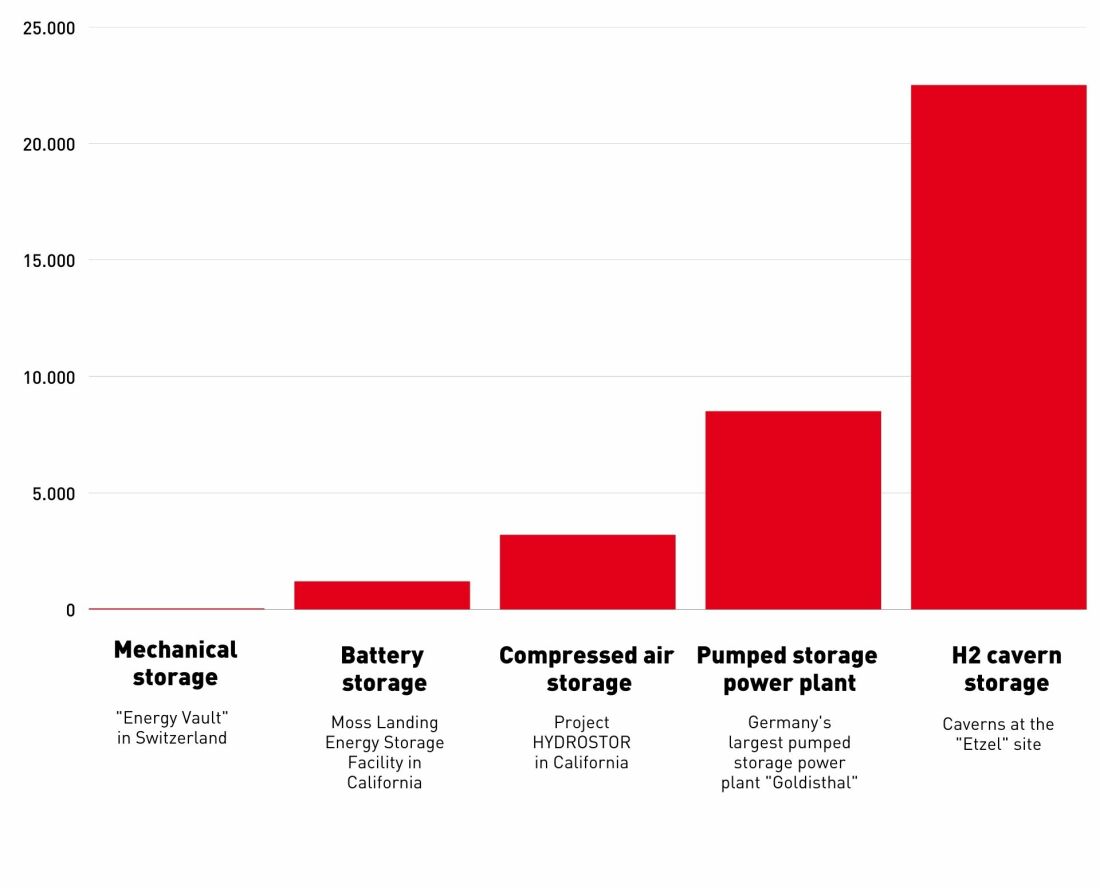
Hydrogen can also take on this role – excess electricity can be fed into electrolysers, where it is converted into hydrogen. This would be used for the transportation or industrial sectors or even to generate electricity for the power grid, if it was fed back into the grid from power stations. One benefit of this method is that, like natural gas, vast quantities of hydrogen can be stored in subterranean spaces such as caverns, many of which are already located in North Germany.
In contrast to other energy storage technologies, they offer great scalability because caverns and tanks can be constructed on a major scale. Many of the other storage options are still either at the prototype stage or, for example, building new reservoirs in Germany for pump storage power stations, are barely feasible in practical terms.
Summary: Where Is It Worth Using Hydrogen?
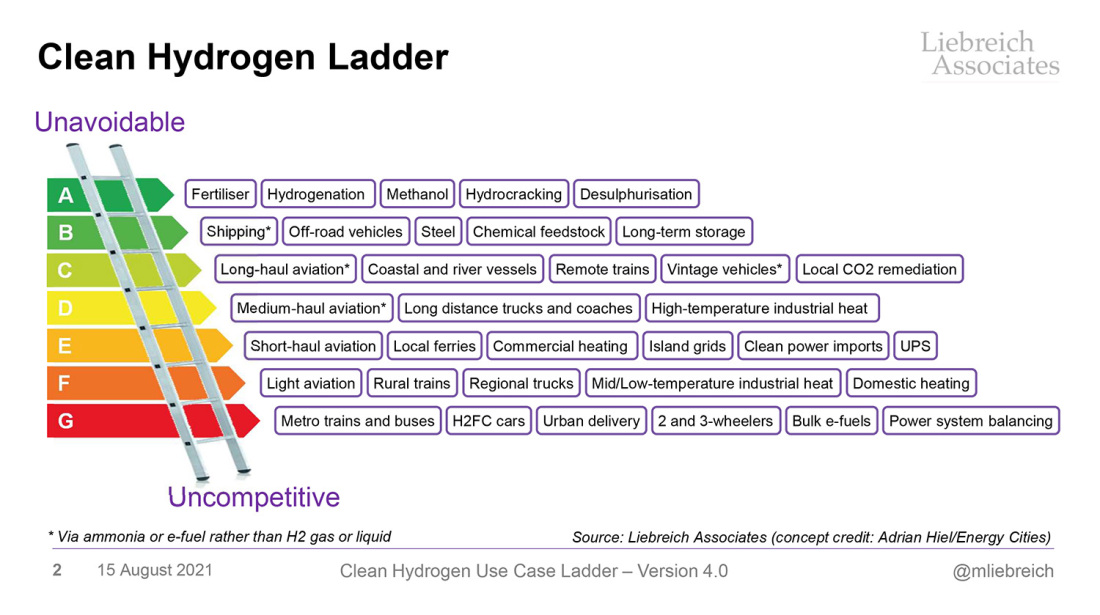
Hydrogen is an essential raw material for our society. It also offers the prospect of being used as a means of storing power, both in the transportation sector and in the stationary electricity supply industry, and replacing fossil raw materials. And there's no way round the fact that green hydrogen will have to be produced on a major industrial scale for use in the chemicals industry.
The sectors in which hydrogen will finally be used, and in which there are still alternative solutions, is not yet clear, even though a ranking order has already emerged (see graphic above). If production capacities increase in future, costs will continue to drop and this will, in turn, open up new areas of application.
More information about the practical use of hydrogen
The Wasserstoffwirtschaft (hydrogen-based economy) office in Bremen is available as a point of contact for questions about every aspect of how this climate-neutral gas might be used in future. It coordinates and runs the activities involving hydrogen in Bremen and is part of a network of partners at regional and international level.
You will find more information about how hydrogen is used in Bremen on our Hydrogen overview web page.
Success Stories
10 Wind Energy Companies in Bremen – this is where the Wind comes from
Bremen is a pioneer in wind energy. Around 80 companies have set up operations here, covering the entire value chain – from planning and financing to manufacturing and services. We showcase ten businesses that illustrate just how strong the wind energy sector is in Bremen.
Learn moreLetters from Türkiye: Summer 2025 edition
Türkiye is focusing on high-tech innovation in order to achieve long-term growth. Will it succeed? Our Türkiye expert Erol Tüfekҫi explains in our country report.
Learn more8 Bremen Companies involved in Mass Spectrometry
If you want to get down to the smallest building blocks of our world, you need mass spectrometers. And there are few places in the world where there is such a high concentration of specialists and manufacturing companies and suppliers in this sector as in Bremen.
Learn more